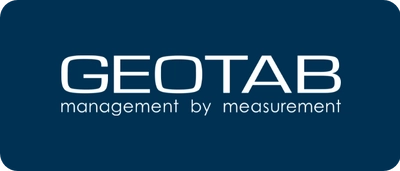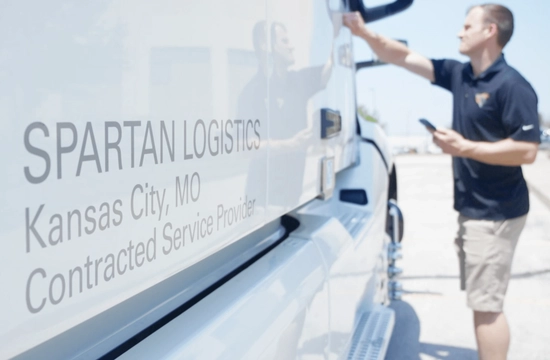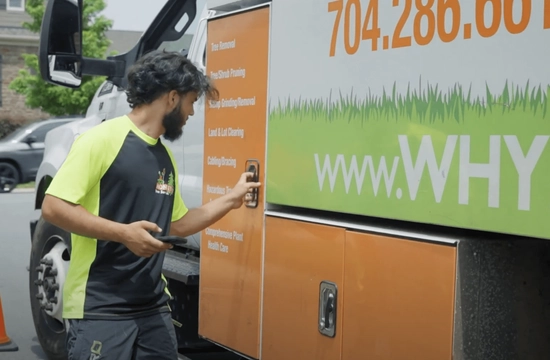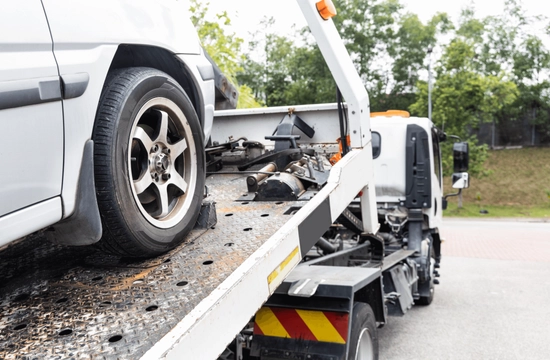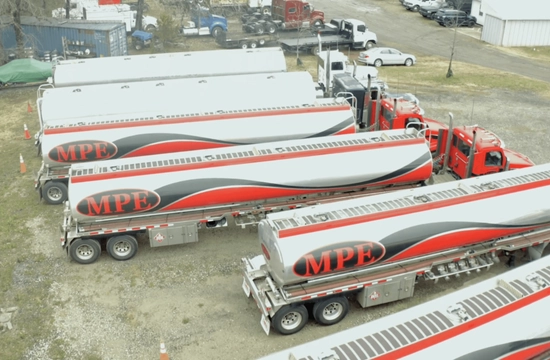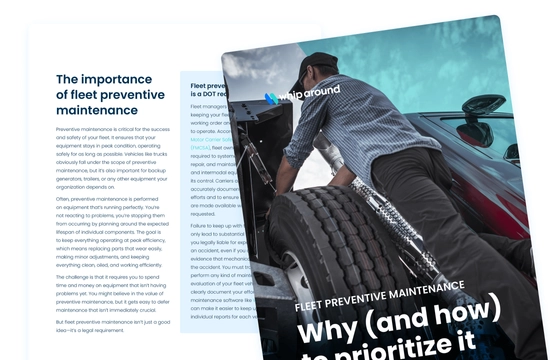- SolutionsMaintenance
Fleet maintenance software for vehicles and equipment
ComplianceEverything you need to keep your fleet compliant with the DOT
InspectionsVehicle inspection software that keeps you compliant and cuts costs
ReportingAccess the vital data you need to optimize the performance of your fleet
Fuel ManagementTrack fuel usage in real time and maximize profitability through fuel cost tracking
IntegrationsSee all - CustomersFeatured Case StudiesSee all
![Spartan Logistics]() Spartan Logistics
Spartan LogisticsSpartan Logistics is a safer, more efficient business by keeping their maintenance up and costs down with Whip Around.
View case study![Monster Tree Service]() Monster Tree Service
Monster Tree ServiceWhip Around gives Monster Tree Service visibility on vehicle & equipment location, condition, what work is due and what has been completed
View case study![Northwest Repossession]() Northwest Repossession
Northwest RepossessionNorthwest Repossession saves tens of thousands of dollars every year by staying totally compliant with Whip Around.
View case study![M. Pittman Enterprises]() M. Pittman Enterprises
M. Pittman EnterprisesThe team at M. Pittman turned to Whip Around for a digital solution to take the guesswork out of their preventive maintenance process.
View case study - ResourcesFeatured ContentSee all
![eBook: Fleet preventive maintenance: Why (and how) to prioritize it]() eBook: Fleet preventive maintenance: Why (and how) to prioritize it
eBook: Fleet preventive maintenance: Why (and how) to prioritize itEverything you need to make preventive maintenance a priority for your fleet.
View eBook![eBook: Creating a preemptive culture of safety, compliance, and preventive maintenance]() eBook: Creating a preemptive culture of safety, compliance, and preventive maintenance
eBook: Creating a preemptive culture of safety, compliance, and preventive maintenanceHow to build a preemptive culture of safety in six steps.
View eBookResource Type - Pricing
17 Vehicle Inspection Secrets to Keep your Fleet Moving
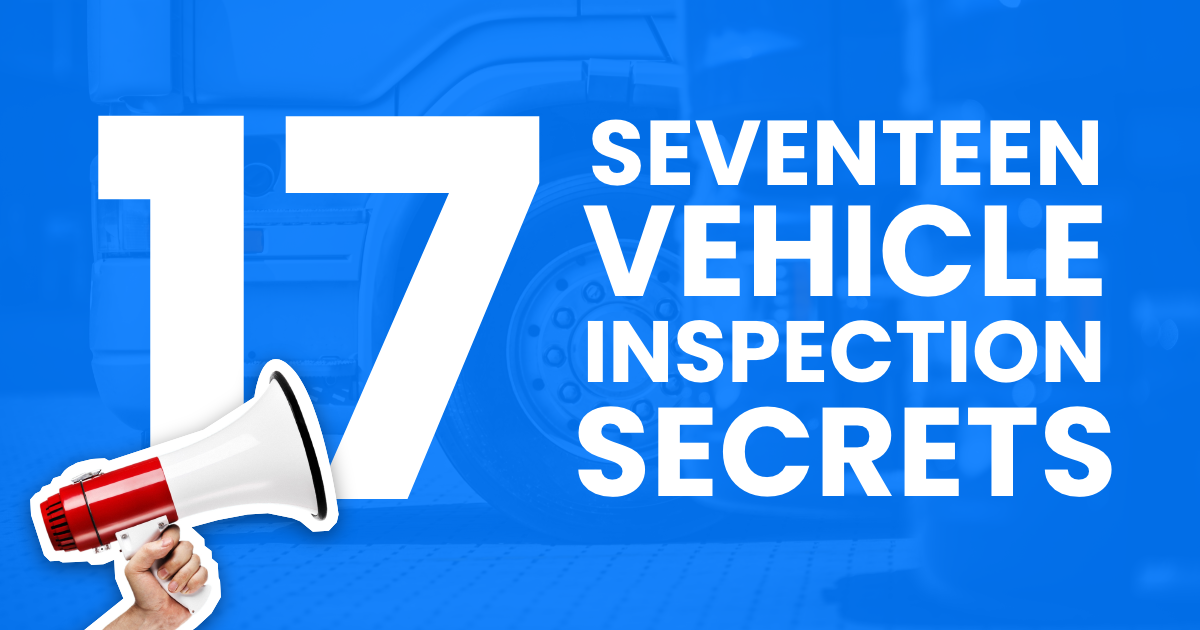
A lot goes into keeping your fleet moving, but none more important than inspecting the vehicles your drivers are climbing into each day.
According to G2, the industry is experiencing about an 8% increase in the adoption of fleet management technology last year, and a trend we see continuing well into the next decade.
This includes technology used to inspect vehicles and equipment in your fleet.
While 2 or 3-ply forms are still very common in industries like construction, landscaping, and even trucking, businesses that are moving away from paper or spreadsheet-dependent inspection processes are simply at an advantage.
If you find yourself needing to change a few of your current processes…keep reading. In this post, we’ll uncover 17 of the best vehicle inspection secrets to separate your fleet from the rest of the pack.
1. Implement a process to ensure inspections aren’t missed
Missed inspections can be a huge cause of concern when it comes to staying compliant with the DOT, and oftentimes the root cause of many undocumented damage cases.
Since catching small problems before they become bigger problems is key, it’s important to put some sort of system in place to allow drivers to notify managers whenever these are missed.
This could be something as simple as a daily text message reminder.
We recommend as a best practice to have this happen automatically by using a DVIR tool like Whip Around, which allows managers to set up automatic missed inspection reminders for drivers, sending a reminder straight to their device, as well as via email if needed.
2. Make vehicle data collection and analysis a priority
Vehicle inspection reports locked away in a filing cabinet, or a line item on a forgotten spreadsheet can have the best and most complete data in them, but it simply won’t do you any good in the long run.
To help determine what vehicles may be experiencing the most problems historically, or knowing when maintenance is due based on vehicle mileage, you really need to be conducting inspections digitally.
If you’re going to be collecting pre or post-trip inspections anyway, why not use this information to spot trends and inform your decision making?
The video below outlines how Steve Crawford Trucking was facing this exact problem, and have since been able to leverage the data they are legally obligated to collect for compliance purposes by using Whip Around.
3. Create policies and procedures around your inspection process
Your business is likely pretty different from others, and with that said you may have checklists you would like drivers to follow prior to conducting an inspection that are unique to your business.
This may include things like:
- Reminding drivers to remember a safety vest
- Instructions on where to park
- Where to turn in inspection forms (if still using paper)
This is why it’s such a good idea to have simple policies and procedures documentation as a part of your new driver onboarding, as well as something that you communicate and make available to team members on a regular basis.
This will ensure drivers are conducting everything leading up to and following an inspection with consistency across the board according to the documentation provided.
4. Configure inspection checklists in an order that makes sense
One of the main problems with ELDs that include some sort of DVIR functionality, (as well as paper forms), is that the order of inspection items isn’t optimized for a walkaround inspection. Typically, they are in alphabetical order.
Over time, this can add unnecessary minutes onto each daily pre and post-trip inspection, leading to unnecessary hours each week for larger fleets ( since drivers will be taking multiple trips around the vehicle).
Configuring this process is done best when inspections are conducted with a mobile app and platform like Whip Around, since the order of inspections can be easily configured for drivers by fleet managers who organize these inspections on the backend.
5. Don’t forget trailers, equipment, and other assets
While you may not need to inspect all the equipment your team uses every single day, it’s important to have an inspection process in place for assets other than vehicles.
As an example, many equipment manufacturers like CAT will offer specific inspection instructions for their equipment which can be used to create a digital version. While vans or trucks can be in perfect working order, taking inventory of assets used on the job is equally as important.
6. Know your inspection requirements for compliance
Are you conducting vehicle inspections because you’re bound by DOT regulations, or for convenience? What about any OSHA regulations?
At any rate, it’s important to know exactly what you need to be inspecting, what location is appropriate to store these reports by law, as well as how long to keep inspection records.
If you’re bound by FMCSA regulations, check out our post Question Answered: How Long to Keep Driver Vehicle Inspection Reports and Where? for more information on what’s required to stay compliant as a motor carrier.
7. Avoid handwriting wherever possible (not only related to inspections)
Poor and illegible handwriting has been known to cause major problems in industries like healthcare, leading to unnecessary tests and malpractice claims. The same general concept applies to trucking and other transportation-related businesses.
Illegible handwriting can cause mechanics to misinterpret what is written on work orders, potentially leaving vehicles in an unsafe state.
This is another key benefit digital vehicle inspection software can offer right away. This makes the process of adding comments error-free and clear, without physically needing to locate a paper form or track down a driver in order to verify specific details.
8. Have a plan for periodic inspections
For bulldozers, trailers, cranes and derricks, or any other assets that may not be in use every day, it’s still essential to make these part of your inspection process since proof of periodic inspections are required by law in many cases.
Many of our customers use Whip Around to perform periodic inspections on equipment ranging from lawn mowers to cranes, and the possibilities really are endless.
Most manufacturers have manuals and equipment inspection guides that can easily be re-created digitally. These assets can easily be added to the Whip Around platform at any time for tracking purposes and when it’s time to inspect them.
9. Create checklists for the small stuff
Outside of your standard inspection checklist items like checking tires and mirrors, another important inspection checklist items like cleaning out the cab, restocking hand sanitizer, and a number of other smaller tasks are a great idea to include.
While many standard paper forms don’t include these items, they are still important to keeping your fleet and drivers safe and shouldn’t be overlooked.
For example, cleanliness checks are something that you can have drivers verify prior to beginning a trip, and a good way to hold team members accountable if you are slip-seating.
10. Create inspection instructions with annotations
With trucks and vehicles being more complex than ever, it may be a mistake to assume every driver will know exactly what do looks for when running through a checklist.
As a best practice, it’s a good idea to provide a short illustration and description of what’s required.
When configuring inspection items, managers can provide annotations that will make it easy for drivers to know what to look for, and what to do.
11. Ensure inspection data is a part of your preventative maintenance strategy
Ever missed an oil change by a few thousand miles? Most of us have been there a time or two.
When it comes to the health of your fleet, not having a mechanism in place to utilize mileage information collected during routine inspections (for example) can mean that oil changes are missed more often than they should be.
While keeping tabs on one or two vehicles may not be a problem, maintenance reminders triggered based on digital data points are essential for growing fleets, by taking the guesswork and human error out of remembering what vehicles are due for service.
12. Ensure proper attire is worn and PPE kits are audited
From gloves, to helmets, to safety vests, proper attire and auditing your PPE safety kits is a critical component of meeting OSHA requirements you should be auditing on a regular basis.
For walkaround inspections specifically, checking the integrity of various components of the vehicle may involve using a driver’s hands, in which case reminding drivers to use gloves if needed is a great idea.
Especially during winter months where it may be cold and raining, providing drivers with touchscreen gloves (for inspections) and proper attire for bad weather are small details that drivers will appreciate.
13. Create driver safety protocols
As simple as it sounds, including any safety protocols like winter driving best practices and wellness checks can really go a long way in ensuring drivers know that you care.
While it only takes a few minutes to send out a company-wide email or text each morning, this is a strategy that can be incorporated into whatever set of tools your team is currently using.
As an example, in the middle of COVID-19, adding a driver wellness component to the daily pre and post-trip inspection process was a feature many of our customers decided to take advantage of.
14. If using tablets or mobile devices, ensure equipment is in good working order
If outfitting a fleet with tablets or devices, one of the seemingly trivial but very important steps is to ensure drivers have what they need to use technology effectively.
This could mean investing in screen wipes, mounts, ensuring devices are properly updated and functioning, or having accessories like charging devices always available and in good working order at all times.
Getting used to using new technology can sometimes take a few months for drivers to get adjusted, but having backup chargers and accessories in place at all times can make this transition much less stressful.
15. Invest in driver orientation and training
Especially with a growing fleet and continually bringing on new drivers, having a driver orientation and training process in place is one of the best ways to ensure your team knows what is expected of them and how to use the technology you have implemented.
It’s also a great idea to provide educational resources and opportunities to pick up additional certifications they may be desiring.
16. Leverage photos as part of your inspection process
Photos –or better yet, required photos are a great way to not only add more descriptive details related to an inspection when faults are identified, but also to ensure there is proper evidence in place to keep drivers accountable for damage they may or may not have caused.
Not only can mandatory photos help ensure inspections are actually completed and not pencil-whipped on an inspection sheet, they also can help speed up the process for mechanics working on repairs by adding additional context.
17. Go digital – and finally move away from paper
Most of these inspection secrets so far have been related to going digital, because this really is the most important part of implementing a vehicle inspection process that is ready for the challenges in today’s fleet management climate.
Are you currently experiencing problems related to drivers not turning in inspection forms, pencil whipping, or compliance and safety concerns with your current process?
Request a demo of Whip Around today and we’ll walk you through how Whip Around can put an end to these common problems.
It’s time to keep your fleet moving by changing inspections and maintenance from one of your biggest weaknesses to your biggest strength.

